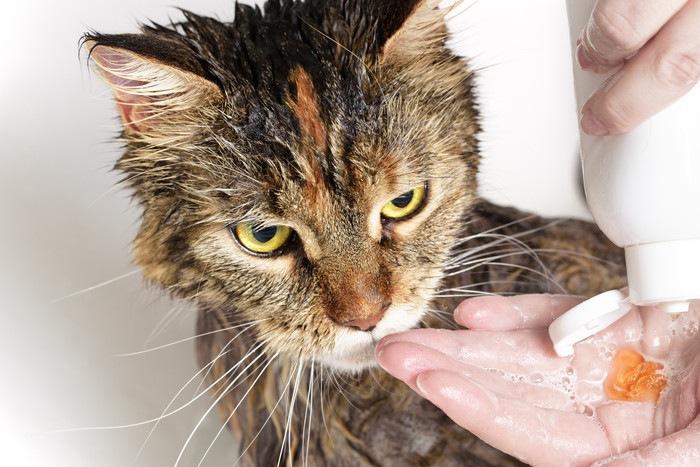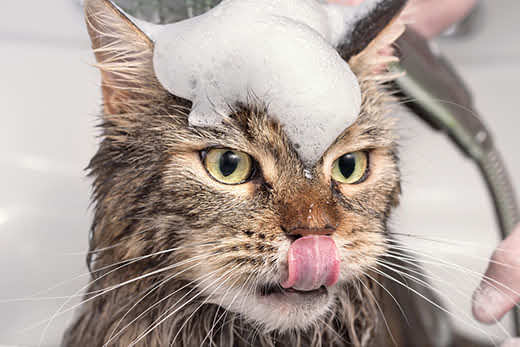
Can you wash your cat with dog shampoo?
Since cats are so meticulous about grooming themselves, you might think that bath time will never come for them. However, there are times when they may need a little help in the bathroom.
The first thing to do is figure out the best way to wash your cat. Do I need to buy a special shampoo for cats or will the one bought for dogs work? Can you bathe cats with human shampoo?
When it comes to bathing your cat, it’s important to use a shampoo designed specifically for them.
Contents
Bathing a cat: what products can not be used
A cat can become dirty and smelly if it gets smeared with substances that are potentially harmful to it, such as car lubricants, or products that are toxic to cats. She may get fleas or ticks. In this case, water procedures will become inevitable. She probably won’t like it, but it’s important to keep her healthy.
When bathing a cat, care must be taken to ensure that it does not ingest any toxic ingredients and avoid products that can harm it. First of all, you should not use shampoos that are not intended for cats.
What shampoo to bathe a cat
Some dog shampoo ingredients may contain substances harmful to cats.
International Cat Care warns that they contain ingredients that are toxic to cats, such as permethrin. Cat liver lacks certain proteins (enzymes) that can break down certain chemicals into harmless forms. This means that such a chemical will accumulate in the animal’s body and can cause serious illness, writes International Cat Care.
Permethrin is a synthetic form of pyrethrin, a substance derived from chrysanthemum flowers. In some cat care products, this ingredient is found in small amounts, but it is best to avoid it altogether.
Similarly, shampoo for dogs with dandruff may contain ingredients that are harmful to cats. If your pet has fleas or skin problems such as flaking, you should consult your veterinarian about safe and effective shampoos.
Can a cat be bathed in human shampoo?
Under no circumstances should human shampoo be used on cats or dogs. It can “cause inflammation and skin irritation in your pet,” reports Preventive Vet. This, in turn, will lead to increased itching and, in some cases, skin infections. These adverse skin reactions are due to the fact that human shampoo is designed for people who have a pH level – a scale of acid and alkaline compounds – that differs from that of a cat.
Some harmful human shampoo ingredients include parabens, sulfates, isopropyl alcohol, coal tar, and some preservatives. They can damage the kidneys and liver. Even baby shampoo can be too harsh for cats, notes Cat Health.
How to wash a cat at home
If you are going to bathe your pet, you need to choose only those shampoos that are designed specifically for cats. They should be soft, odorless and drug-free. If your cat needs a medicated shampoo, check with your veterinarian before using it.
 To reduce the risk of exposure to harmful substances during bathing, you should always read labels and check for ingredients that seem unfamiliar. This also applies to cat shampoo alternatives that include mild dish detergents. They can be harsh on a cat’s sensitive skin and contain natural ingredients such as essential oils that are not safe for furry pets. This is why the Royal Society for the Prevention of Cruelty to Animals of Australia recommends that all ingredients of any homemade cat detergents be thoroughly tested. Again, when in doubt, it’s best to call your veterinarian and discuss the ingredients.
To reduce the risk of exposure to harmful substances during bathing, you should always read labels and check for ingredients that seem unfamiliar. This also applies to cat shampoo alternatives that include mild dish detergents. They can be harsh on a cat’s sensitive skin and contain natural ingredients such as essential oils that are not safe for furry pets. This is why the Royal Society for the Prevention of Cruelty to Animals of Australia recommends that all ingredients of any homemade cat detergents be thoroughly tested. Again, when in doubt, it’s best to call your veterinarian and discuss the ingredients.
In order for the problems of bathing tailed family members to be disturbed as little as possible, it is necessary to regularly care for the cat. This includes brushing or combing at least once a week or more often, depending on the breed. When you run out of cat shampoo, don’t reach for dog shampoo or your own. It’s best to purchase a cat-safe shampoo so you have a spare for any bathing emergency.





